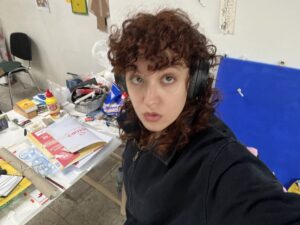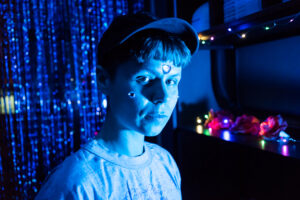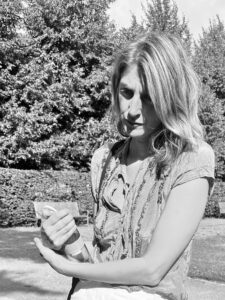Ágnes Eperjesi

– born in 1964. She graduated in 1989 from the then freshly launched, photography-centred department of Visual Communication and Typography of the Hungarian Academy of Applied Arts, where she pursued her Master degree in Visual Communication. She obtained her DLA from the Hungarian University of Fine Arts in 2010 and is teaching at the Intermedia Department of the institution since 2011. Throughout her career characterized by a consistently built visual language and intellectual vocabulary, Eperjesi has been examining media theoretical questions and the social consequences of the use of media. In her practice, the artist examines with sensitivity and almost scientific methodology the specificities of the photographic medium, its unexplored possibilities and meanings, as well as the power contexts that define social existence. Her conceptually oriented works and their intellectual background are not mere theoretical derivatives, but aesthetically high-toned and sensually rich creations. (Excerpt from the artist’s website)
I was always interested in the nature of small changes culminating in larger changes and the potential of the turning point. I explore the disintegration of processes, the visualization and separation of each phase and detect when it is necessary to highlight them as individual entities or if I can grasp the point where the process is no longer reversible. In the beginning this was mainly manifesting in representing physical movement and depicting the turning point12. I’m intrigued by the situations that we can observe while they are changing – certainly those which can reflect themselves and capture these processes3.
For self-reflection and its representation I find photography, especially photograms are the most appropriate media, my colourful photograms prove these aspects. From time to time I keep returning to a series I started in 2014, in which I fold the photosensitive material to itself so the sensation of colour and the spatial nature of the phenomena are simultaneously captured, while the sensation of colour also becomes understandable456.
I approach the forming idea and the hypothesis discovered by my artistic sensitivity with research and experiments, supported by the experiences I gain during practical work. During the process of researching the idea is also transforming – this is the way I usually find the medium of my works, though sometimes the results of my research form the idea. My aim is to unearth and understand deeper references between seemingly inconsistent things. My works are built on the analytical observation of various phenomena. I would highlight Dóra Maurer as one of my masters – she was the first person in my life who made me aware how this attitude of life can be related to art.
I often used bodies in my works; I was interested in the movement and the anatomical specifics of the body, rather than its gender. The only moment it became important that I am a woman was when I wanted to have a child, as my body is able to bear a baby. This is the only motif in the series of my works when my biological sex played a role. Together with Tibor Várnagy I wanted to document with objectivity and on a real scale how a woman’s body is changing during the pregnancy. In addition, this biological process is in line with the essence of photography called latency and with thinking about photography as a medium as well. I would mention here my installation titled Newborns7, in which I took photograms about babies of my friends and my own daughter who was born only a few days before. “Labor”, my exhibition presented in 2015 is the synthesis of my thinking about the medium of photography. In this show I connected my earlier works with new ones such as the work titled Latency/Pregnant8, in which I used photograms about my pregnant body created in 1992.
The founding of the Work Photo Theory Choir that stages texts about theory of photography in a playful way is also related to this exhibition. As a matter of fact, my whole artistic career can be interpreted from the viewpoint of the medium of photography, although I rarely take pictures or even use a camera. Instead of the gesture and action of capturing with a camera I find another kind of performativity that I unfold in the medium.
It might seem strange but I became aware of gender through my own work, while I was creating the artworks for the series Recycled Images. Until that time, I had a limited knowledge about gender – I believed, as so many others did, that only work matters, nothing else. The series is based on a collection of images – which I am building approximately since 1989 – of transparent packages and directions for use of products printed on them. Because of their transparency it was obvious for me to handle them as quasi negatives and make blow-ups of them. The collection was kind of thematizing itself while growing and the images were systematized. The abundance of working hands formed the Busy Hands9 series. I realized that 95 percent of the hands doing chores were female hands. Since I have a view on the nature of sexism, I am handling it more consciously – this helps me navigate in life and also creates space for artistic and social reflection10. Plastic bags also appear in my new genre public art project, the action called Advertisement-FreeZone.
In the performance11 and exhibition You Should Feel Honoured I attempted to compare classical art and the sexism of state socialism through an exact case that arose in a chaotic period leading to the regime change in Hungary. I wanted to focus on inequalities produced by art, as art is a field where a number of examples can be found for the reproduction of the prevailing patterns. These traditional forms reproduced by art are resonating with other forms of exploitation: women are seen as raw material, serving biological and natural needs in many segments of society. Although these forms in other fields are no taboo for art, they are for art itself. Using the case study does not exclude me from connecting my work with the case of women. The stake of the sculpture and project titled Pathos and Critique12 was to find possible visual narratives and modes of representation, which are as sensitive topics as talking about victims.
Observing the stations of change is not only a medium specific question for me, but also a social one. My starting points are my personal experiences but I create artworks of them only if they align with general experiences I come across during my research. This also applies for my works related to my interest in science and experiments with colours. My works are not directly derived from my personal experiences but from the social, political and scientific aspects I explore analytically. My works are parts of my life so they are always political. I also made openly political artworks that I created when I found the arrogance of the ones that own political power in Hungary humiliating and its social consequences problematic13. The rhythm of repetition and change in my work sometimes has a very personal dimension, but at the same time, it also incorporates sensitivity towards social issues. Such as the work 365 days of D.14, in which the patterns of the life and ego of a man struggling with autism is shaped by the objects formed by him as an everyday activity.
The final version of the statement was written in collaboration with art historian Kata Balázs (2020).
1Image: Ágnes Eperjesi, Systematic Rolling of the Prism in Every Direction, 1-5, 2015 (Completed reconstruction of a series made in 1987), gelatin silver print photograms, 150 x 53 cm. Courtesy of the artist and acb Gallery, Budapest. The text written in the turnip with needles: I want to stay straight.2Image: Ágnes Eperjesi, Step by step, 2016, installation (series of photographs, video, a root curling during the time of the exhibition). Courtesy of the artist and acb Gallery, Budapest. The text written in the turnip with needles: I want to stay straight.
3Image: Ágnes Eperjesi, Somersault, 1987, gelatin silver photo-chemigram, 100 x 120 cm. Courtesy of the artist and acb Gallery, Budapest.
4Image: Ágnes Eperjesi, Möbius, 2020, colour photogram, 26 x 100 cm each. Courtesy of the artist and acb Gallery, Budapest.
5Image: Ágnes Eperjesi, Möbius, 2020, colour photogram, 26 x 100 cm each. Courtesy of the artist and acb Gallery, Budapest.
6Image: Ágnes Eperjesi, Möbius, 2020, colour photogram, 26 x 100 cm each. Courtesy of the artist and acb Gallery, Budapest.
7Image: Ágnes Eperjesi, Newborns, 1996, black and white photograms, 60 x 50 cm each + one piece 60 x1 00 cm, metal structure installation piece, 150 x 150 x 700 cm. Courtesy of the artist and acb Gallery, Budapest.
8Image: Ágnes Eperjesi, Latency/Pregnant, 1992–2015, black and white photogram created with Tibor Várnagy, 1992, photographic paper in light-protective package, 200 x 100 cm. Courtesy of the artist and acb Gallery, Budapest.
9Image: Ágnes Eperjesi, Busy Hands, 2000, c-print, 65 x 150 cm. Courtesy of the artist and acb Gallery, Budapest.
10Image: Ágnes Eperjesi, Self-portrait Pieces, 2001, c-print, text on aluminium, 130x132 cm. Courtesy of the artist and acb Gallery, Budapest.
11Image: Ágnes Eperjesi, You Should Feel Honoured, performance, 2018. Courtesy of the artist and acb Gallery, Budapest.
12Image: Ágnes Eperjesi, Pathos and Critique, 2019, 3D print, metal structure, 180 x 40 x 40 cm. Courtesy of the artist and acb Gallery, Budapest.
13Image: Ágnes Eperjesi, Words of Power, performance in the Hungarian Parliament, 2015, OFF-Biennále, “Check Your Head” program. Courtesy of the artist and acb Gallery, Budapest.
14Image: Ágnes Eperjesi, 365 Days of D., 2017, installation (300 pieces of manually carved soaps completed with concrete, concrete table, black and white photography, slide). Courtesy of the artist and acb Gallery, Budapest. The original soaps were made by Dávid Vedres. The concrete table was designed by Tamás Bene and his team.
– szül. 1964, képzőművész. Tanulmányait a Magyar Iparművészeti Főiskolán (ma MOME) frissen induló, fotográfia-központú Vizuális Kommunikáció és Tipográfia szakon végezte 1989-ben, majd a Vizuális Kommunikáció mesterképzésen folytatta. 2010-ben szerzett DLA fokozatot a Magyar Képzőművészeti Egyetemen. 2011 óta a Magyar Képzőművészeti Egyetem Intermédia tanszékének oktatója. Következetes önálló képi és gondolati világot építő, vizuális nyelvet alkotó pályafutása során párhuzamosan és szervesen von vizsgálódásai körébe médiumelméleti kérdéseket és a médiumhasználat társadalmi következményeit. Munkássága érzékenyen, és szinte tudományos módszerességgel vizsgálja a fotográfiai médium sajátosságait, kiaknázatlan lehetőségeit és jelentéseit, a társadalmi lét meghatározó hatalmi kontextusait. Konceptuális indíttatású alkotásai gondolati hátterükkel együtt sem pusztán elméleti derivátumok, hanem esztétikailag is magas színvonalú, szenzuális gazdagságú művek. (Részlet a művész honlapjáról)
Mindig érdekelt az apró változások összegződéseiből kialakuló nagyobb változások természete és a fordulópont potenciálja. A folyamatok „feldarabolása”, az egyes fázisok önálló megjelenítése, elkülönítése; hogy mikor van értelme ezeket önálló entitásként kiemelni, és megragadható-e az a pont, ahonnan már nem fordítható vissza a folyamat. Ez eleinte főleg a fizikai mozgás, átfordulás ábrázolásaiban jelent meg12. Azok a helyzetek izgatnak, amelyeket képesek vagyunk változás közben megfigyelni – különösen azok, amelyek a változás közben saját magukra is képesek reflektálni és azt rögzíteni3.
Az önreflexióra, annak mediatizált megjelenítésére a fotográfia, pontosabban a fotogram használata számomra különösen alkalmasnak bizonyul; ezekről a szempontokról tanúskodnak a színes fotogramjaim is. Egy 2014-ben elkezdet sorozatban például, melyhez vissza-visszatérek, a fényérzékeny anyagot önmagába hajtom vissza – így a képeken egyszerre rögzül egy színjelenség és képeződik le a jelenség térbelisége, változékonysága, miközben érthetővé válik a színjelenség maga is456
Az érlelődő gondolathoz, a művészi érzékenység révén megorrontott hipotézishez a kutatások és kísérletek során, a gyakorlati munka tapasztalatainak segítségével kerülök közelebb. A keresési folyamat megtapasztalása közben maga a gondolat is alakul – általában így találom meg a munkáimhoz a médiumot és a formát, esetenként pedig fordítva, a kísérleti eredmények alakítják ki magát a gondolatot. Gyakran látszólag összeegyeztethetetlen dolgok közötti viszony mélyebb feltárása, az összefüggések megértése a célom, a jelenségek analitikus megfigyeléséből épülnek a műveim. Mesteremként Maurer Dórát emelném ki – ő volt az első olyan ember az életemben, aki ezt a számomra érvényes élet-attitűdöt a művészetre vonatkoztathatóvá tette.
Többször használtam testeket a munkáimhoz, de nem a test neme, hanem a mozgása, a testanatómiájából eredő lehetőségek érdekeltek. Egyedül akkor vált fontossá, hogy nő vagyok, amikor gyereket akartam, mert azt az én testem tudja kihordani: ez az egyetlen olyan motívum a munkáim sorában, amikor a biológiai nemem szerepet kapott. Egy az egyes méretben, tárgyszerű objektivitással akartam megörökíteni Várnagy Tiborral együtt azt, hogy a nő teste hogyan változik meg a terhesség során. Ugyanakkor ez a biológiai folyamat fedésben van a fotográfia lényegi sajátosságával, a latenciával, és magában a fotográfia médiumában való gondolkodással. Itt említem az Újszülöttek7 című installációt, amelyben a saját néhány napos lányom után ismerősök újszülött gyermekeiről készítettem fotogramokat. A “Labor” című 2015-ös kiállításom pedig a fotográfia médiumáról vallott gondolkodásom szintézise, ahol korábbi munkáimat újabbakkal kapcsoltam össze: ilyen például a Latencia/terhes8 című alkotásom, amelyben a terhes testemről 1992-ben készült fotogramot használtam fel. A kiállításhoz köthető a Munka Fotóelméleti Szavalókórus megalakítása is, mely játékos komolysággal állít színre fotóelméleti szövegeket. Voltaképpen az egész művészi pályám értelmezhető a fotográfia médiuma felől úgy, hogy közben egyáltalán nem fotózok, szinte egyáltalán nem használok kamerát. A kamera általi megörökítés gesztusa és aktusa helyett másfajta performativitást találok meg és bontok ki a médiumból.
Furcsán hangzik, de a társadalmi nemek létezésére a saját munkámon keresztül figyeltem fel, az Újrahasznosított képek című sorozat műveinek készítése során. Addig nem nagyon volt tudomásom arról, hogy van társadalmi nem – abban hittem, ahogy oly sokan, hogy csak a munka számít, semmi más. A ciklus alapját egy átlátszó termékcsomagolások képeiről és a rájuk nyomtatott rajzos használati utasításokból álló gyűjtemény képezi, melyet körülbelül a rendszerváltás óta építek. Az átlátszóságuk miatt magától értetődő volt számomra, hogy kvázi talált negatívként kezeljem őket, és fotónagyításokat készítsek róluk. A gyűjtemény a növekedése és a képek rendszerezése közben voltaképpen önmagát tematizálta. A munkát végző kezek ábrázolásának túlsúlya adta ki például a Szorgos kezek9 sorozatot̶ ekkor tűnt fel, hogy a házimunkát végző kezek körülbelül 95%-a egyértelműen női kéz. Amióta rálátok a szexizmus természetére, tudatosabban kezelem – ez részben segít eligazodni az élet dolgaiban, másrészt művészeti-társadalmi reflexiókra is lehetőséget ad10.A zacskók használata egy new genre public art munkámban is megjelent, a Reklámmentes övezet /Advertisement-FreeZone című akcióban.
Az Érezze megtiszteltetésnek című perfomansz11 és kiállítás során a klasszikus művészet és az államszocializmus szexizmusának összevetését kíséreltem meg egy konkrét, a magyarországi rendszerváltáshoz vezető kaotikus időszakban keletkezett példán keresztül. Itt elsősorban a művészet révén újratermelt egyenlőtlenségekre akartam fókuszálni, mert a művészet olyan terep, amely számospéldát szolgáltat az „uralkodó minta” újratermelésére. A művészet révén újratermelt hagyományos formák pontosan összecsengenek más kizsákmányoló formákkal: a nőket ugyanúgy a természeti és biológiai szükségszerűségek kiszolgálóinak, egyfajta nyersanyagnak tekintik, mint a társadalom más szegmenseiben – csak míg a többi terület a művészet számára nem tabu, önmaga számára nagyon is az. Az esettanulmány használata persze nem zárja ki azt, hogy munkámat a „nők ügyével” kiemelten is összekapcsoljuk. A Pátosz és kritika12 című szobor és a projekt többi művének tétje a lehetséges vizuális beszédmódok, az ábrázolás lehetőségeinek a megtalálása volt, mert az ugyanolyan kényes ügy, mint általában az áldozatokról való beszéd.
A változás stációinak megfigyelése nemcsak mediálisan, hanem társadalmi kontextusban is érdekel. Ebben az esetben is a személyes tapasztalataimból indulok ki, viszont csak akkor lesz mű belőlük, ha a kutatásaim során általánosabb érvényűnek tekinthető tapasztalatokkal érnek össze (ez érvényes a természettudományos érdeklődésemből, azaz a színekkel kapcsolatos kísérleteimből eredő művekre is). Az egyéni tapasztalatokból sohasem közvetlenül, hanem azok társadalmi-politikai-tudományos kapcsolódásainak analitikus feltárásából következnek a műveim. Mivel a munkáim az életem részei, voltaképpen mindig politikusak. De vannak nyíltan politikai témájú munkáim is, melyek jó része olyankor keletkezett, amikor a hatalommal bírók arroganciáját megalázónak, társadalmi következményeit problémásnak éreztem13. Az ismétlődés és a változás ritmusa néha egyszerre kap végletesen személyes és szociálisan érzékeny dimenziót a munkáimban. Ilyen például a D. 365 napja14, amelyben egy autista férfi életének és énjének mintázata ölt formát az általa mindennapos tevékenységként megdolgozott tárgyakból építkezve.
A statement végleges formában Balázs Kata művészettörténésszel együttműködésben született (2020).
1Kép: Eperjesi Ágnes: Prizma szisztematikus görgetése minden irányba 1-5, 2015 (Egy 1987-ben készített sorozat kiegészített rekonstrukciója.), zselatinos ezüst fotogramok, 150 x 53 cm. A művész és az acb Galéria jóvoltából. A fehérrépákba gombostűkkel írt szöveg: Egyenes akarok maradni.2Kép: Eperjesi Ágnes, Lépésről lépésre, 2016, installáció (fotósorozat, videó, a kiállítás ideje alatt becsavarodó gyökér). A művész és az acb Galéria jóvoltából. A fehérrépákba gombostűkkel írt szöveg: Egyenes akarok maradni.
3Kép: Eperjesi Ágnes, Bukfenc, 1987, zselatinos ezüst fotokemogram, 100 x 120 cm. A művész és az acb Galéria jóvoltából.
4Kép: Eperjesi Ágnes, Möbius, 2020, színes fotogram, 26 x 100 cm egyenként. A művész és az acb Galéria jóvoltából.
5Kép: Eperjesi Ágnes, Möbius, 2020, színes fotogram, 26 x 100 cm egyenként. A művész és az acb Galéria jóvoltából.
6Kép: Eperjesi Ágnes, Möbius, 2020, színes fotogram, 26 x 100 cm egyenként. A művész és az acb Galéria jóvoltából.
7Kép: Eperjesi Ágnes, Újszülöttek, 1996, fekete-fehér fotogramok, 60 x 50 cm egyenként+egy darab 60 x 100 cm, vasszerkezet-installációs elem, 150 x 150 x 700 cm. A művész és az acb Galéria jóvoltából.
8Kép: Eperjesi Ágnes, Látencia/terhes, 1992/2015, Várnagy Tiborral készült fekete-fehér fotogram, 1992, 200 x 100 cm fotópapír fényvédő csomagolásban, 50 x 60 cm. A művész és az acb Galéria jóvoltából.
9Kép: Eperjesi Ágnes, Szorgos kezek, 2000, c-print, 65 x 150 cm. A művész és az acb Galéria jóvoltából.
10Kép: Eperjesi Ágnes, Önarckép szeletek, 2004, c-print, szöveg alumíniumon, 130 x 132 cm; A művész és az acb Galéria jóvoltából.
11Kép: Eperjesi Ágnes, Érezze megtiszteltetésnek, performance, 2018. A művész és az acb Galéria jóvoltából.
12Kép: Eperjesi Ágnesi, Pátosz és kritika, 2019, 3D nyomtatás, vasállvány, 180 x 40 x 40 cm. A művész és az acb Galéria jóvoltából.
13Kép: Eperjesi Ágnes, Hatalmi szóval, performance a Parlamentben, 2015, OFF-Biennále, “Check Your Head” program. A művész és az acb Galéria jóvoltából.
14Kép: Eperjesi Ágnes, D. 365 napja, 2017, installáció (300 kézzel kivájt szappan betonnal kiegészítve, betonasztal, fekete-fehér fotó, dia). A művész és az acb Galéria jóvoltából. Az eredeti szappanokat Vedres Dávid készítette. A betonasztalt Bene Tamás és csapata tervezte.



